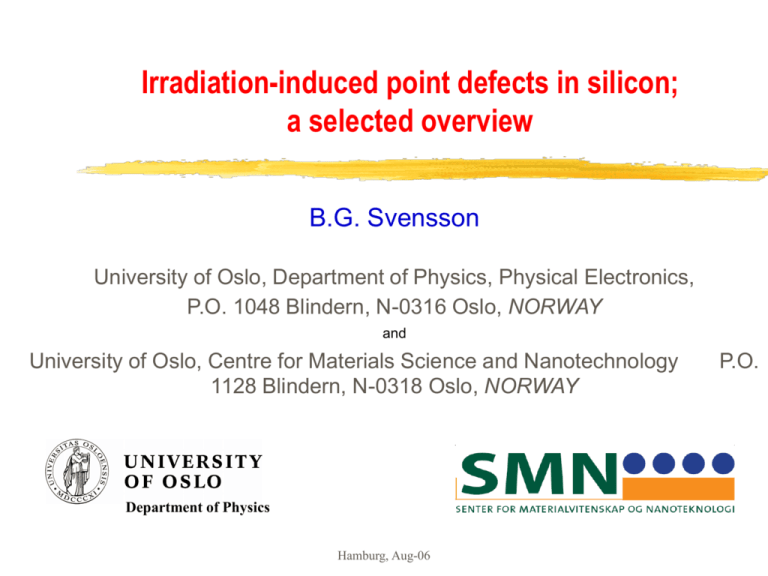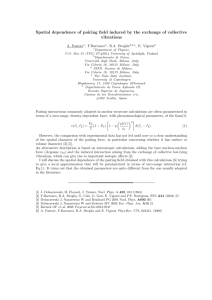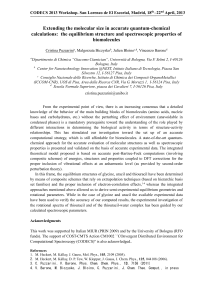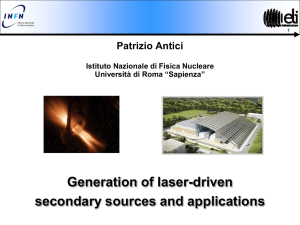Outline
advertisement

Irradiation-induced point defects in silicon; a selected overview B.G. Svensson University of Oslo, Department of Physics, Physical Electronics, P.O. 1048 Blindern, N-0316 Oslo, NORWAY and University of Oslo, Centre for Materials Science and Nanotechnology 1128 Blindern, N-0318 Oslo, NORWAY Department of Physics Hamburg, Aug-06 P.O. ’Restrictions’ - ’Detector perspective’ – emphasis on electrically active defects - Room Temperature (RT) irradiation (unless stated otherwise) DV ~ 10-8-10-9 cm2/s, DI ~10-4 cm2/s - Mainly lightly doped material (1012 - 1015 cm-3) - Mainly dilute concentrations (109 – 1014 cm-3) - O, C, H, (P, B) – NOT metallic impurities HH, Aug-06 Indirect measurements and calculations of DI in silicon Compiled by: W. Taylor et al., Rad. Eff. 111/112, 131 (1989) D. Eaglesham, Physics World, Nov-1995, p. 41 Typical DLTS-spectra P+-n--n+ MCz diode Nd~5x1012 cm-3 6 MeV e-, 5x1012 cm-2 E4 Bleka et al., ECS Trans, in press (2006) Silicon Oxygen (Oi) Interstitial configuration Vacancy oxygen (VO) center (0/-) EC 0.17 eV EV For given irradiation conditions and low doses (<1014 cm-2), the production of VO is identical irrespective of the detector material used (SFZ, DOFZ, MCz, epi) !! What about OII? Most likely, it does exist as evidenced by IR and EPR measurements, (LVM at 944 and 956 cm-1), in combination with low-temperature (LT) irradiation Low binding energy, stable only up to 200-250 K !! Further, OI2 (LVM at 936 cm-1) does probably also exist and is stable up to ~80 ºC. It forms directly during RT irradiation with fast neutrons and after LT-irradiation with MeV electrons + heating to RT (OiI + I OI2) Hermansson, Murin et al., Physica B 302/303, 188 (2001), and references therein The E-center; VP, VAs, VSb Acceptor-like state at Ec-0.44 eV Dominant in highly doped Fz-Si (1016 cm-3) Anneals at ~150 ºC (charge state dependent) G.D. Watkins, J.W. Corbett, Phys. Rev. 134, A1359 (1964) L.C. Kimerling et al., Sol. Stat. Comm. 16, 171 (1975) S.D. Brotherton, P. Bradley, J. Appl. Phys. 53, 5720 (1982) …… Most probably, of limited importance in n--detector layers but dominant in n+-contact layers The V2-center Four different charge states (=,-,0,+) with corresponding levels at Ec-0.23, Ec-0.43 and Ev+0.20 eV The most prominent intrinsic defect stable at RT J.W. Corbett, G.D. Watkins, Phys. Rev. Lett. 7, 314 (1961) …… Presumably of key importance in n-/p- detector layers, either directly or indirectly Generation of VO and V2; mass effect 6 MeV 11B 8 -2 6 MeV B (1x10 cm ) -> 65 cm FZ n-Si 0.015 DLTS signal ( C / C ) 6 MeV e- E C - 0.17 eV 0.42 eV 0.010 0.23 eV E4 0.005 0.000 100 150 200 250 300 Temperature (K) Importance of V2 (and higher order clusters) increases with increasing elastic energy deposition (NIEL), e.g., neutral hadrons Generation mechanism for V2 Svensson, Lindström, J. Appl. Phys. 72, 5616 (1992) ’Direct’ generation of V2 prevails (pairing of V’s formed by different impinging electrons is negligible)! Linear correlation between VO and V2 generation 2 MeV e-, 1018 cm-2 P-type Cz (~7 Ωcm) Lindström et al., J. Appl. Phys. 53, 5686 (1982) 1.5 MeV e-, 1014-1015 cm-2 N-type Fz and Cz (~3 Ωcm) Wang et al., Appl. Phys. Lett. 33, 547 (1978) Oehrlein et al., ,J. Appl. Phys. 54, 179 (1983) ’Direct’ generation of V2 prevails and identical annihilation process for VO and V2. [Cs] has a crucial impact by suppressing V+I→Ø ! Impurity engineering of high-purity Si The role of Cs may be indirect N-type epi (110 Ωcm, 50 m, MBE-grown) N-type Fz (75 Ωcm) 1.3 MeV H+ Generation of VO is strongly reduced in low-doped high-purity epi!! In fact, VP dominates ([Ps]~4x1013 cm-3)! Annealing of VO and V2 VO + Oi → VO2 DOFZ-Si VO V + Oi H + VO → VOH H + VOH → VOH2 V2 + Oi → V2O V2 V + V Monakhov et al., PRB 69, 153202 (2004) H2 + V2 → V2H2 (?) V2O VO + V ........ DVO~5e-1.8(eV)/kT cm2/s Ediss(VO)~2.0 eV DV2~0.003e-1.30(eV)/kT cm2/s Ediss(V2)~1.7-1.8 eV Ediss(V2O)~2.0 eV [Ec-0.43 eV] vs [Ec-0.23 eV] during annealing of Hydrogenated DOFZ V2H is not a major ’player’!! linear fit: y=A+Bx A=0.0100.002 B=0.980.02 Monakhov et al., PRB 69, 153202 (2004) Interstitial carbon (Ci) Three different charge states (-,0,+) with corresponding levels at Ec-0.10 and Ev+0.27 eV Extremely well-studied defect (PL, EPR, IR..) and it is the source of a multitude of other defects (including Ci-I (?)) G. Davies and R.C. Newman, Handbook of Semiconductors, Eds T.S. Moss, S. Mahajan (Elsevier, Amsterdam, 1994) ch. 21, p. 1557 Carbon is of key importance in n-/p- detector layers, either directly or indirectly Cs has a strong impact on the overall defect generation via its role as I-trap Evolution of Ci at RT; an illustration 8 3.2 MeV H + --> p-type Si Fz (~15 Ωcm) Ev +0.35 eV DLTS signal (10 -3 dC/C) 6 Ci O i Ev +0.27 eV [Oi]~1.2x1016 cm-3 295 K Ci [Cs]≤5x1015 cm-3 4 h after implant 23 h 4 47 h Ev +0.20 eV V2 2 0 100 150 200 250 300 Temperature (K) Lalita et al., NIMB 120, 27 (1996) 1:1 proportionality between loss of Ci and growth of CiOi 7 Growth of the E v +0.35 eV level (10 -3 C/C) 3.2 MeV H + --> p-type Si 6 295 K 5 4 Slope: 0.99 3 2 1 0 0 1 2 3 4 5 Loss of the E v +0.27 eV level (10 -3 C/C) 6 7 Lalita et al., NIMB 120, 27 (1996) 10 Ev + 0.27 eV level Interstitial Carbon (C (C i)i ) C/C) 295 K DLTS signal (10 -3 1.5x10-5 s -1 I + Cs --> Ci Ci + Oi --> CiOi; [O i]>>[Ci] 1 d[Ci]/dt = -k[Ci] ==> [Ci]=[Ci]0exp(-kt) k=4RDCi[Oi] (DCi=1-2x10-15 cm2/s at 295 K) 0 10 20 30 40 50 Time (h) Cf value by Tipping, Newman, Semicond. Sci. Techn. 2, 315 (1987) D = 0.4exp(-0.87(eV)/kT) cm2/s Lalita et al., NIMB 120, 27 (1996) Interstitial carbon – interstitial oxygen (CiOi) At least two different charge states (0,+) with a corresponding level at Ev+0.35 eV, dominant in ’p-type spectra’ Extremely well-studied defect (PL, EPR, IR..) Stable in excess of 300 ºC, Ediss~2.0 eV Jones, Öberg , Phys. Rev. Lett. 68, 86 (1992) Potential candidate as trap for migrating I’s; CiOi+In (n1) but such complexes are not yet confirmed spectroscopically for n>1 Dicarbon center (CSCi) Bistable with three different charge states (-,0,+) and levels at Ec-0.17 and Ev+0.09 eV for A-configuration (Ec-0.11 and Ev+0.05(?) eV for B) Important in C-rich (O-lean) material Extremely well-studied defect (PL, EPR, DLTS...) Song et al., Phys.Rev.B42, 5765 (1990) Stable up to 250 ºC, Ediss~1.7-1.9 eV Potential candidate as trap for migrating I’s; CsCi+In (n1) and spectroscopic (optical) signals have been tentatively identified DLTS signals of CsCi and VO overlap 6 MeV 11B → n-type FZ (65 Ωcm) Normalized DLTS signal 0,0035 DLTS Signal ( C/C) 0,003 0,0025 0,002 0,0015 1,2 1 T=79 K 0,8 CiCs filling 0,6 0,4 0,2 VO filling 0 1,E-08 1,E-06 1,E-04 1,E-02 1,E+00 1,E+02 10-8 10-6 10-4 10-2 1 102 Filling Pulse Duration (s) 0,001 0,0005 0 70 120 170 220 270 320 370 Temperature (K) Lévêque et al., J. Appl. Phys. 93, 871 (2003) In oxygen-lean material the contributions from VO and CSCi can be comparable (Filling-pulse measurements (or annealing) can be used to distinguish)! Hydrogen and irradiation-induced defects N-type Fz, 175 Ωcm Ec-0.45 eV Ec-0.32 eV Svensson et al., Mat.Sci.Eng. B4, 285 (1989) Irmscher et al., J. Phys. C 17, 6317 (1984) At least two H-related defects are clearly resolved where the shallow one has later been firmly identified as VOH with a donor state at Ev+0.27 eV! 1 He (5 MeV) 0.9 0.8 e (2 MeV) ’XH’ 0.7 0.6 0.5 0.4 H (680 keV and 1.3 MeV) 0.3 O (16 MeV) 0.2 Br (46 MeV) 0.1 0 -7 -5 -3 -1 1.E-07 1.E-05 1.E-03 1.E-01 10 10 10 10 Vacancies/Å/projectile Lévêque et(Vacancies/Å)/projectile al., EP-JAP 23, 5 (2003) 1.2 1.0 Relative density [Ec-0.23 eV]/[E c-0.42 eV] Evidence for a third irradiation-induced defect involving H 0.8 0.6 Ec-0.32 eV Ec-0.45 eV XH VOH VH V2H 0.4 0.2 0.0 1 1.E+01 10 0 100 200 300 Annealing temperature (ºC) Annealing Temperature (oC) Comparison between DLTS (data points) and EPR results by Bonde-Nielsen et al., Physica B273/274, 167 (1999) Lévêque et al., EP-JAP 23, 5 (2003) The H-related level at ~Ec-0.43 eV (XH) is tentatively assigned to V2H Summary of findings for H + RT irradiation VOH (0/-) Ec-0.32 eV, (0/+) Ev+0.27 eV Forms directly during irradiation if free H is available Occurs frequently during VO and V2 annealing in ’H-rich’ material Stable at temperatures in excess of 300 ºC VH (0/-) (?) at Ec-0.45 eV with sn~10-17 cm2 ’Free’ H is required for formation Disappears at ~200 ºC V2H (0/-) (?) at ~Ec-0.43 eV, overlaps strongly with V2(0/-) Disappears at ~250 ºC In lightly doped n-Si-detector material; [H], [H2]<1014 cm-3 and even in intentionally hydrogenated DOFZ no effect is found below 200 ºC which implies ’strong’ trapping of the hydrogen by, e.g., carbon-related centers like CsCiH (T-center) 15 MeV e- Hydrogenated DOFZ-Si VO 2h in H plasma at 300 ºC N+-side exposed (700 mTorr) V2(=/-) VOH Monakhov et al., PRB 69, 153202 (2004) V2(-/0) Some ’hot issues’ I-center (0/-) Ec-0.55 eV, (0/+) Ev+0.58 eV (?) A key defect for type inversion (Neff) and leakage current in g-irradiated p+-n--n+detectors Quadratic dose dependence, suppressed in DOFZ ’Standard’ interpretation and modeling of the oxygen effect suggest an identification as V2O. This is, however, not consistent with annealing data for V2 and theoretical model of V2O... Can we exclude involvement of carbon?? Clusters Influence of the W- (and X,J..) center? Small I-clusters (?) with shallow states appearing after neutron/ion irradiation... How important is the di-interstitial, I2? Mobile at RT (Emigr~0.9 eV)?! Similar generation rate as V2?! Vacancy clusters? E.g., V6 is expected to be quite stable and should be detectable by electrical techniques?! Is broad band PL useful? Role of the oxygen dimer, O2? Emigr~1.4 eV, [O2]~1014 cm-3 in DOFZ/MCz, interaction with other defects?

 Meson in Radiative (2S) Decay Please share](http://s2.studylib.net/store/data/012097016_1-fe4561dc640d194f3c36aa8090a7dacf-300x300.png)

